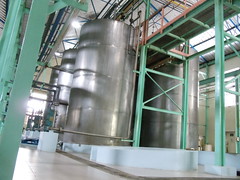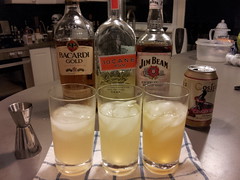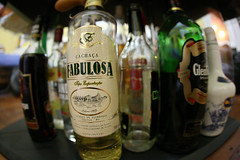
Intro to Rum & Cachaça:
The tricky thing about Rum is that it’s produced worldwide and there really aren’t any governing bodies that say what Rum is and what it isn’t. It’s generally accepted that rum is a spirit made with sugar cane products – either molasses or fresh cane juice. Cachaça is also made with fresh cane juice, but with a slightly different process than Rum – so we’ll discuss it separately.
We’ll talk about Rum in this section in a couple different ways:
- By the location or language of the rum-producing country
- By the way in which it’s made / how long it’s aged
How Rum is Made:
Again, there is no standard for how rums are made, so we will be making a few generalizations here.
- Rum is always created from sugarcane, either from sugarcane juice or from molasses.
- Since the source is already sugar-rich, it’s not necessary to cook prior to fermentation
- The sugarcane juice / Molasses is fermented and then distilled. Different countries require different minimum % alcohol by volume.
- Rums are usually aged after distillation, in stainless steel tanks or used bourbon casks.
- Finally, rums are often blended before sale to help maintain flavor consistency.

Rum, by Geography
Caribbean Rums:
The following framework is a generalization that can help differentiate some of the different rums produced in the Caribbean. Other rums produced in other areas of the world don’t necessarily follow these rules, but since more than 80% of global rum production is sourced from the Caribbean, this should be helpful for most rum purchases.
- Spanish Speaking Countries: Due to the prevalence of Puerto Rican rum in the USA, the Spanish-speaking countries’ style is most common in the USA. This type is generally very smooth and often aged.
- English Speaking Countries: Rums manufactured in English speaking islands like Jamaica and Guyana often retain more of a molasses flavor. They are generally known for their darker color and fuller taste.
- French Speaking Countries: Rums from French speaking countries generally use sugarcane juice and as a result retain more of the sugarcane flavor. They are also called “Rhum Agricole” which is French for “Cane juice Rum.” Since sugarcane is more expensive than molasses, these rums also tend to be more expensive.
Outside the Caribbean:
Rum is produced everywhere sugar cane is grown, and sugar cane is grown worldwide. Producers exist on every continent except Antarctica. This contributes to the variety of styles available in the market today.

Grades of Rum
Again this section represents quite a few generalizations to help explain an extremely varied spirit. These grades should cover most common rums available through major distributors.
Light to Dark:
Rums can be found in colors ranging from perfectly clear to deep, dark brown. In general, the color comes from spending more time in barrels, and comes along with the flavors that barrels typically bring.
Grade |
How it’s made |
Flavor |
Use in Cocktails |
| Light, Silver or White Rum | Typically spends very little time in a barrel. Sometimes filtered to ensure clear color | Subtle, sweet flavor. Generally bring some of the flavor of what it’s made of – sugarcane or molasses. | Great choice for cocktails when looking to add an inherent sweetness without introducing barrel flavors. Also a good choice when it’s important not to introduce color. |
| Gold or Amber Rum | Aged in wooden, sometimes charred barrels. | Midway between light and dark rum grades. | Similar to when you would use light rum, but adds some spiced and caramel notes. |
| Dark Rum | Spends the most time in heavily charred barrels. | Strongest flavor of the rum grades, and darkest color. Flavors like caramel, baking spices and molasses are prevalent. | Great candidate when you are looking for a dense, rich cocktail with the flavor of molasses and a hint of spice. |
Other Types:
Type |
How it’s Made |
Flavor |
Use in Cocktails |
| Overproof Rums | Rum is typically distilled to at least 70% and then watered back down to bottle strength (40%). Overproof rums haven’t been watered down as much. Any rum over 60% (120 proof) is considered an “Overproof” Rum. | Higher alcohol content will mean the alcohol taste will be more prevalent. Brings a strong rum flavor. | This is a good choice when your cocktail needs a strong spirit to cut through the richness of other full-bodied ingredients. |
| Spiced Rums | Typically infused with spices like cinnamon, vanilla, allspice, ginger, and star anise. | Brings the flavor of whatever it was infused with. Typically even sweeter than non-spiced rums. | Spiced rums work well when your cocktail needs a spirit that is both sweet and brings some spice. Remember to adjust for the added sweetness that spiced rum brings. |
| Flavored Rums | Rums which have had flavors added. | Whatever flavor has been introduced. Typically also comes with a chemical flavor or aftertaste. | I don’t recommend using in cocktails. If you’re looking to bring flavor to your cocktails, there a lot of other great ways that don’t risk a chemical aftertaste. |
| Premium Rums | Typically made by boutique distillers and aged at length. Recipes vary. | Barrel flavors are prevalent and bring a caramel, almost cognac or bourbon quality. | Similar to Añejo tequilas, premium rums are generally enjoyed straight, not mixed in cocktails |
Cachaça

Cachaça is also made of fresh pressed cane juice, and some people call it “Brazilian Rum.”
How it’s Made:
Cachaça is made in much the same way as rum, with a few deviations:
- Producers often put other ingredients in the mix during fermentation – things like toasted corn meal, rice bran, and oats.
- After fermentation, Cachaça is only required to be distilled to between 38-54% alcohol (compared to 70% for rum). This means many of the flavors and impurities from the fermented sugar & grains remains in the final product.
- Cachaça manufacturers can add up to 6 grams of sugar per liter of their final product.
- Finally, Cachaça is not required to be aged after distillation (though it certainly can be.)
Cachaça in Cocktails:
Cachaça tastes like rum with herbal, grassy qualities. The addition of grains and sugar result in a truly unique, savory flavor. The addition of sugar enhances and enriches the mouth feel as well.
Like Rum, Cachaça may be aged in barrels or not. The “White” variety is typically bottled immediately after distillation. This is the type most commonly seen in cocktails. Dark cachaça is aged up to three years and typically consumed straight as a sipped drink.

